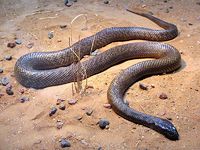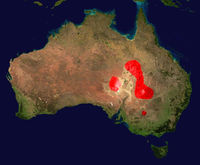Inland taipan
| Inland taipan | ||||||||||||||||||||
|---|---|---|---|---|---|---|---|---|---|---|---|---|---|---|---|---|---|---|---|---|
 Inland taipan
| ||||||||||||||||||||
| Scientific classification | ||||||||||||||||||||
| ||||||||||||||||||||
| Binomial name | ||||||||||||||||||||
| Oxyuranus microlepidotus (McCoy, 1879)[1][2] | ||||||||||||||||||||
 Distribution of the Inland taipan in Australia
| ||||||||||||||||||||
| Synonyms | ||||||||||||||||||||
|
The Inland taipan (Oxyuranus microlepidotus), also commonly known as the Fierce Snake is native to Australia and is often cited as being the worlds most venomous land snake species based on LD50 values in mice. It is a species of taipan belonging to the family Elapidae and the subfamily Hydrophiinae. Although highly venomous, it is a very timid, reclusive and non-aggressive species that inhabits the remote, semi-arid regions in middle Australia.
Etymology
This species was described by Irish palaeontologist Frederick McCoy in 1879.[3] The generic term "Oxyuranus" is of Greek origin and means pointy-tail. The specific epithet "microlepidotus" also originates from the Greek language and means small scale. The word "micro" is Greek for small and the Greek word "lepidos" means scale.[4]
Description
A medium to large snake, slender and robust snake with a relatively long whip-like tail.The head is elongate, rectangular (but slightly shorter than O. scutellatus and with a greater slope from the frontal to the rostral) and distinct from a narrow neck. The head and body scales are smooth and relatively glossy. Head is more round snouted than other species in this genus. Scales in the neck region are small. The average size of an adult specimen is about 1.2 m (3.94 ft), but this species can attain lengths of 2.5 m (8.2 ft). Males and females attain similar body sizes. The largest inland taipan reliably measured and reported in the literature was a female with a snout-vent length of 1.7 m (5.58 ft). The largest total length recorded is 2.5 m (8.2 ft).[5][6] Dorsal colour varies from pale fawn to yellowish-brown to dark brown, with the head and neck being several to many shades darker than the body. Colour changes seasonally, with individuals becoming darker in winter and fading in summer. Many dorsal scales have a blackish-brown lower anterior edge which creates a broken herring bone pattern along the length of the body. The ventral surface is yellowish with orange blotches; this colour often extends to the lowermost lateral scales. The eyes are large, with a very dark iris' and round pupils.[7]
Scalation
Midbody scales in 23 rows, ventrals 211-250, anal scale single, subcaudals divided.[7]
Distribution and habitat
Geographical distribution
The inland taipan mainly exists in central Australia. The species occurs in the Channel country of south-western Queensland and north-eastern South Australia. There are two old records for localities further south-east, i.e., the junction of the Murray and Darling Rivers in northwestern Victoria (1879) and "Fort Bourke", New South Wales (1882); however the species has not been collected in either state since then.[7][8]
Habitat
The inland taipan prefers the dry, arid climate of the Australian outback. Inland taipans are associated with the deep cracking-clays and cracking-loams of the floodplains, however they also venture onto nearby gibber plains, dunes and rocky outcrops if cover is available. The vegetation in these areas is usually sparse, consisting of chenopod shrubs, lignum and the occasional eucalypt near the water channels.
The snakes shelter in soil cracks and crevices, and in holes and mammal burrows.[9]
Behaviour and ecology
Behaviour and habits
The species is primarily, if not exclusively, diurnal in its activity on the surface. They are most active in the early half of the morning, briefly basking and foraging in or near deep soil cracks and animal burrows, before retiring to shelter for the rest of the day. In cooler weather the snakes may also be found active in the afternoon. Road-killed specimens have been found in "winter", hence the species is presumably active on the surface at this time of year. The seasonal change in body colouration presumably helps the inland taipan to warm up quickly during the cooler months (dark colour) and avoid overheating in the warmer months (pale colour). It is an extremely efficient hunter. Its bite is fast and accurate and its venom potent. It usually holds onto its prey until the prey succumbs to the venom. It likes to shelter in rat burrows, deep soil cracks and sink holes and occasionally in rock crevices. Timid, alert and relatively placid species which may not attempt to escape if approached. If cornered or provoked it will coil in loose, open loops with the forebody slightly raised and strike and release rapidly (usually more than once) if within range.[8][9][10]
Diet
Oxyuranus species are unique among Australian elapids in feeding exclusively upon endothermic prey. The inland taipan preys on a wide variety of mammals and marsupials, including the long-haired Rat (Rattus villosisimus), as well as the introduced house mouse (Mus musculus) and various small dasyurids. Prey is usually cornered in a burrow or soil crack before being bitten several times in quick succession. The venom acts so rapidly that the snake can afford to hold on to its prey instead of releasing (to avoid injury) and waiting for it to die.[9]
In captivity these snakes may also accept day-old chicks in addition to rats and mice.[7]
Predators
Juvenile inland taipans often fall prey to birds of prey and they're also killed by humans, either accidentally (running a snake over with a car) or purposely.[8]
Reproduction
Behaviour typical of male combat has been recorded occurring in late winter between two large, but unsexed, individuals. During the approximately half-hour combat, the snakes intertwined, raised their heads and forebodies and "lashed out" at each other with closed mouths. Inland taipan have also been observed presumably mating in the wild in late winter. Females with oviducal eggs can be found in mid-spring (second half of November). Clutch size ranges from 11-20, with 16 being the average. The eggs measure 6 x 3.5 cm when laid and take 9-11 weeks to hatch at 27-30°C. Newly-hatched young have a total length of around 47 cm (18.5 in) long.[5][9]
Venom
The Inland taipan's venom is made up of pre-and post-synaptic neurotoxins, myotoxins, and procoagulants. It consists of taipoxin and protease enzymes, the average quantity of venom delivered by this species is 44 mg and the maximum dose recorded is 110 mg. The subcutaneous LD50 is approximately 0.025 mg/kg.[11] The median lethal dose (LD50) for mice is 2 μg/kg (ppb) for pure taipoxin[12] and 30 μg/kg (ppb) for the natural venom mixture.[13] Its venom consists mostly of neurotoxins. As of late 2003, all positively identified inland taipan bite victims have been herpetologists handling the snakes for study, and all have been treated successfully with antivenom—no incidents have been fatal.[14][15]
Cited references
- ↑ Oxyuranus microlepidotus (TSN 700647) at Integrated Taxonomic Information System. Accessed 15 May 2012.
- ↑ Oxyuranus microlepidotus (MCCOY, 1879) at The Reptile Database. Accessed 15 May 2012.
- ↑ McCoy, F. 1879. Small-scaled brown snake. Proc. Zool. Vict. 3: 12-13.
- ↑ Etymology of Oxyuranus microlepidotus at Australian Reptile Online Database. Accessed 15 May 2012.
- ↑ 5.0 5.1 Shine, Richard. Covacevich Jeanette. (1983). Ecology of Highly Venomous Snakes: the Australian Genus Oxyuranus (Elapidae). Journal of Herpelology. Vol. 17. 1. 60-69 pp.
- ↑ Inland taipan: General details at Clinical Toxinology. Accessed 15 May 2012.
- ↑ 7.0 7.1 7.2 7.3 Inland Taipan at Australian Museum. Accessed 15 May 2012.
- ↑ 8.0 8.1 8.2 Kendall, Philip. (1995). The Taipan: The World's Most Dangerous Snake. Kangaroo Press. ISBN 0864175965
- ↑ 9.0 9.1 9.2 9.3 Cogger, H.G. (2000). Reptiles and Amphibians of Australia. Sydney: Reed New Holland 808 pp. ISBN 1-876-33433-9
- ↑ Wilson, Steve. Swan, Gerry. (2011). A Complete Guide to Reptiles of Australia. New Holland Publishers (UK). 558 pp. ISBN 1877069760
- ↑ Subcutaneous LD50 Menu at Venom Doc. Accessed 15 May 2012.
- ↑ J. Fohlman, D. Eaker, E. Karlsoon, S. Thesleff (1976). "Taipoxin, an extremely potent presynaptic neurotoxin from the venom of the australian snake taipan (Oxyuranus s. scutellatus). Isolation, characterization, quaternary structure and pharmacological properties". Eur. J. Biochem.: 457–69. PMID 976268.
- ↑ Strength of Venom. School of Chemistry, University of Bristol. Retrieved on 2008-02-29.
- ↑ Barrett, Robyn; Mark Little (Oct–Dec 2003). "Five years of snake envenoming in far north Queensland". Emergency Medicine 15 (5–6): 500–510. PMID 14992068. Retrieved on 15 May 2012. “There have only been a handful of reports of envenoming by the inland taipan (Oxyuranus microlepidotus). As in our patient, they have only occurred in herpetologists.”
- ↑ White, Julian (November 1991). Oxyuranus microlepidotus. Chemical Safety Information from Intergovernmental Organizations. Retrieved on 15 May 2012.